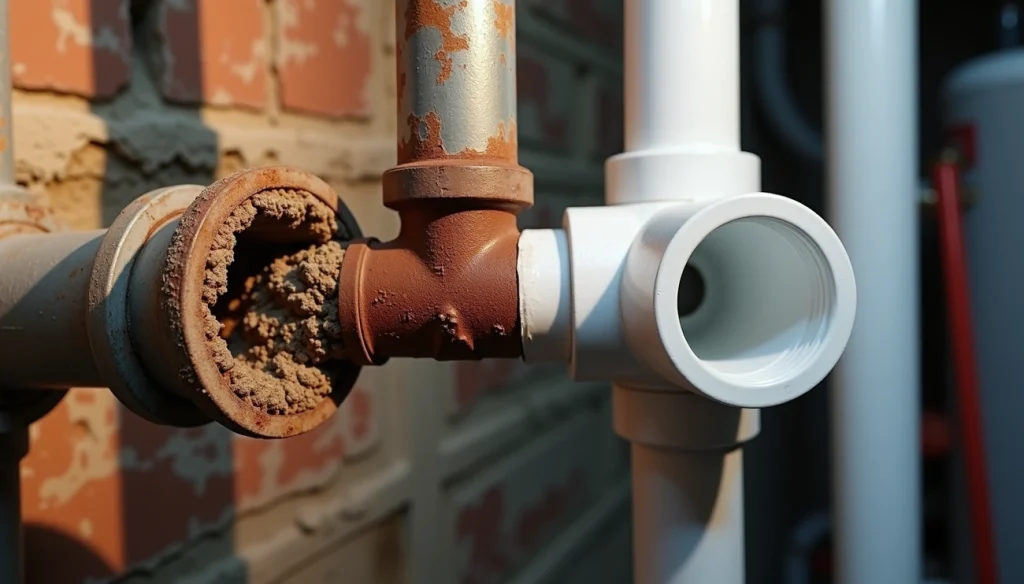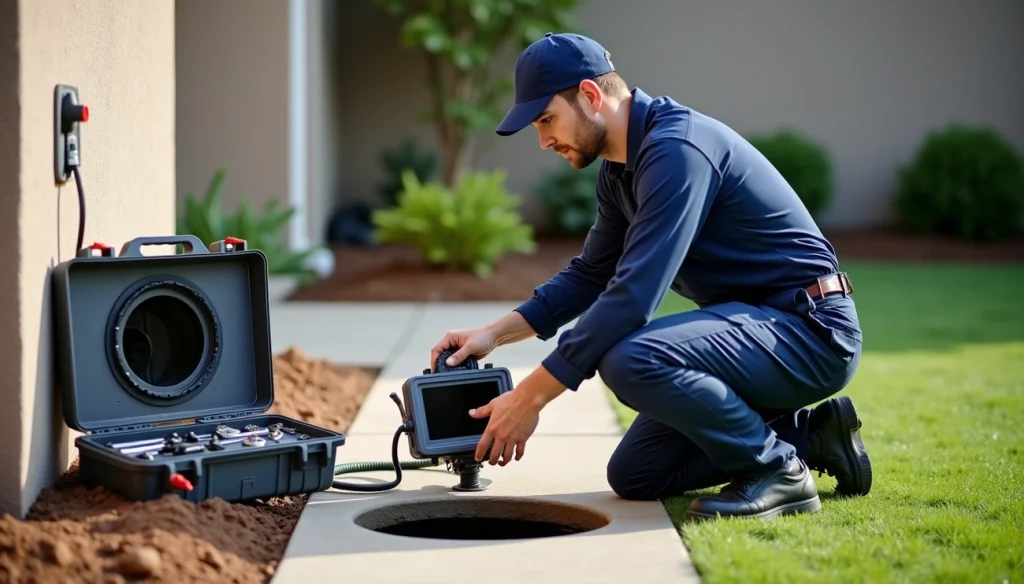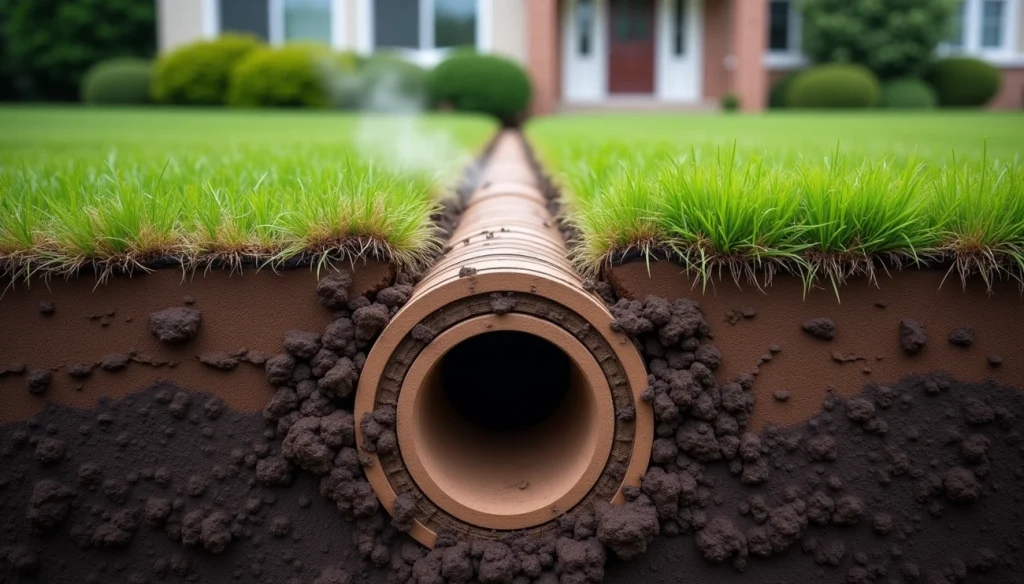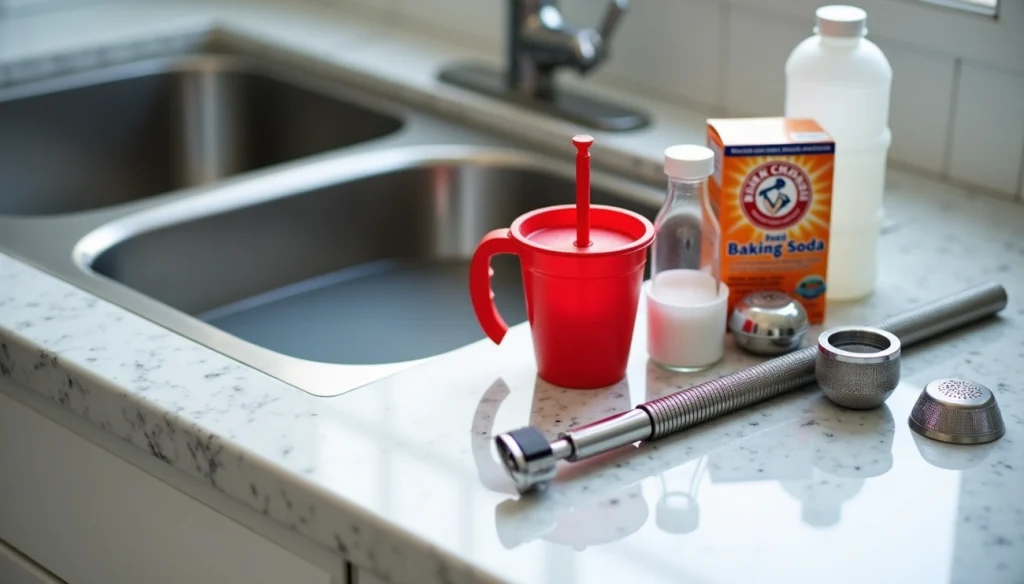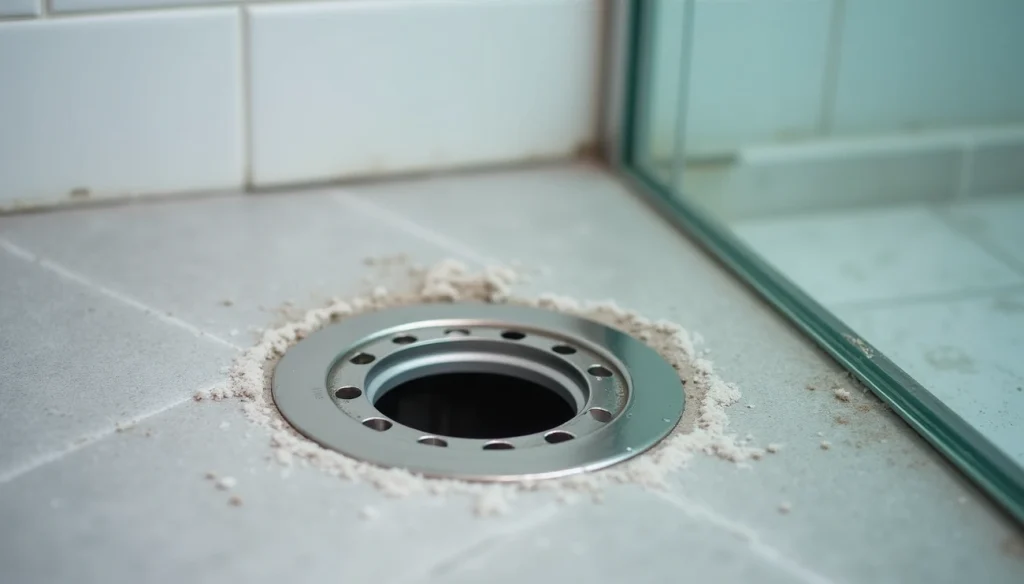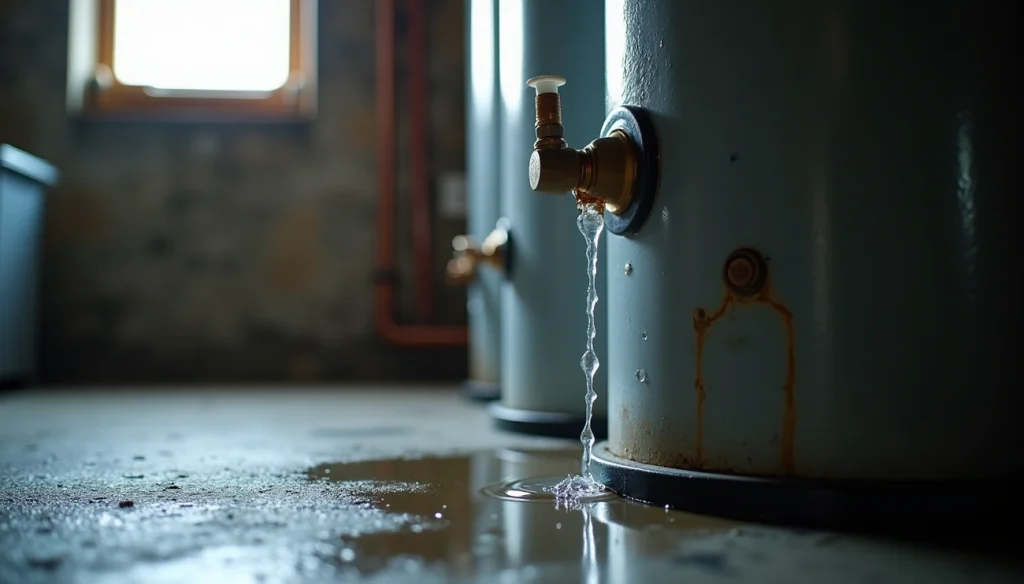A staggering 4.7 million people have searched online to fix their clogged bathtub drains. No surprise there – a bathtub that won’t drain ranks among the most frustrating household problems.
Cleaning experts with decades of hands-on experience point to hair and soap scum as the main culprits. Many people reach for chemical drain cleaners, but think about this: these harsh products can hurt your lungs, burn your skin, and eat away at your pipes.
Here’s the silver lining – you don’t need a plumber or dangerous chemicals to unclog your bathtub. Simple items from your kitchen like baking soda and vinegar can clear that drain in just 15 minutes.
Want your bathtub to drain like new again? Let’s tuck into these tested methods that will protect your wallet and spare you future headaches.
Note: If your bathtub is overflowing and nothing is working, you might need an emergency plumber. Western Rooter can help!
Identifying Your Bathtub Clog Type
The first step to fix your bathtub drain clog is knowing what’s causing it. Every homeowner deals with this plumbing problem at some point. The quickest way to unclog your drain is to identify the type of blockage you’re dealing with.
Common signs of different clogs
Each type of bathtub clog shows unique symptoms that help you find the root cause:
Hair Clogs: These are the most important type of bathtub drain blockages. Slow drainage that gets worse over time points to hair as the main cause. Hair combines with soap residue and creates tough blockages that slow down water flow.
Soap Scum Buildup: White stains on shower walls along with drainage problems usually mean soap scum is blocking your pipes. This substance hardens inside the pipes and sticks to the sides until it creates a major blockage. Your pipes might make gurgling sounds as water tries to squeeze through the narrow space.
Mineral Deposits: Hard water leaves invisible mineral deposits in homes. You can’t see these minerals, but they build up on pipe walls and reduce water flow. The water drains slowly even when there’s no visible debris near the drain opening.
Dirt and Debris: Sand and dirt can quickly clog your drain after beach trips or when kids play outside. These clogs usually appear suddenly instead of building up over time.
Combined Clogs: All but one of these blockages mix multiple materials. Hair, soap scum, mineral deposits, and debris work together to create stubborn clogs. These mixed blockages show several symptoms at once.
Quick test to determine clog severity
Check how bad your clog is before you try to clear it:
The Water Test: Pour an inch of water into your bathtub and time the drainage. A minor clog takes about a minute to drain. A severe blockage needs several minutes or won’t drain at all.
The Plunger Test: A plunger should move the clog. If nothing happens when you plunge, you likely have a big blockage deep in your pipes.
The Multiple Fixture Check: Your clog might extend beyond the bathtub. Look for bubbles in the toilet bowl when you run tub water. Also, check if toilet flushes make water back up into the tub. These signs mean the blockage is in your main sewer line.
The Sound and Smell Check: Gurgling drains point to partial clogs that create turbulence. Bad smells suggest trapped organic matter is rotting in your pipes – a sign of serious blockage.
The Visual Inspection: Take out the drain stopper if you can and shine a flashlight down the drain. Hair and debris near the opening show a surface clog that’s easier to fix.
Knowing your bathtub clog’s type and severity will give you the tools to pick the right unclogging method. This knowledge saves time and money on unnecessary fixes.
Tackling Hair Clogs in Your Bathtub Drain
Hair clogs are the biggest problem for bathtub drains everywhere. You’ll need specific tools and techniques to remove those stubborn strands after spotting a hair clog. The good news is you can restore proper drainage without calling a professional plumber.
Using a drain claw or zip tool
A drain claw (also called a zip tool) tackles hair clogs and works really well on most bathtub blockages. This cheap plastic tool has barbed edges that grab onto hair and debris when you pull it up.
Here’s the quickest way to use a drain claw:
- Remove any visible drain cover or stopper
- Insert the tool straight down into the drain until you feel resistance
- Twist it gently so the barbs catch the hair
- Slowly pull the tool upward to extract the clog
- Dispose of the removed hair and debris
Your zip tool can reach about 18-25 inches into your drain, making it perfect for clogs in the upper portion of your pipes. Most homeowners fix their drainage issues within minutes using just this method. You can reuse the tool, though some models work just once.
Pro tip: Put the tool in several more times after removing the first clog to get all the debris out. Clogs often build up in layers, and taking out just the top might not fix your drainage completely.
Bent wire hanger technique
The wire hanger method is a no-cost solution using stuff you probably have at home. This DIY approach works like commercial drain claws but lets you adjust and customize it more.
Creating and using your DIY drain cleaner is simple:
Start by straightening a wire coat hanger with pliers. Then bend one end to make a small hook that catches hair while fitting through the drain opening. Push this hook end into your drain and twist it clockwise several times. The hook collects hair and debris from the drain as you pull up.
This technique lets you adjust the hook’s size and shape based on your drain’s setup. The wire’s stiffness also gives you better control than plastic tools when working through pipe bends.
Caution: Use wire hangers carefully since too much force could scratch porcelain tubs or damage plastic pipes. Make sure your hook is small enough to avoid getting stuck.
Removing the drain stopper
Getting to deeper clogs often means taking out the drain stopper completely. This step matters because drain stoppers usually trap hair and create blockages.
Bathtub drains come with different stopper types:
Pop-up stoppers: Look for a small screw on the cap to loosen. After that, unscrew the whole stopper by turning it counterclockwise.
Lift-and-turn stoppers: Try turning the stopper counterclockwise while gripping firmly. If it spins freely, check for a set screw that needs loosening.
Flip-it stoppers: These usually unscrew directly counterclockwise or have a cap that comes off before you can reach the main screw.
Push-pull stoppers: These connect to parts behind the overflow plate. Take off the overflow plate to disconnect everything.
Check the stopper carefully for hair and buildup after removing it. Clean all parts with bathroom cleaner before putting them back. This way, you’ll fix the current clog and stop future ones from forming.
WD-40 can help loosen stubborn, corroded stopper parts. You could also pour hot water and vinegar down the overflow drain to dissolve built-up gunk that might be keeping the stopper stuck.
Note that removing the stopper gives you direct drain access, so your drain claw or wire hanger can reach deeper clogs better.
Dissolving Soap Scum and Product Buildup
Soap scum and product buildup create stubborn bathtub clogs that test even the most patient homeowner’s nerves. Hair clogs can be removed by hand, but soap residue creates a sticky layer inside pipes that slowly blocks water flow. You can dissolve these deposits with common household items without needing a professional plumber.
Hot water flush method
Boiling water is one of the quickest ways to clear minor soap scum clogs. This method works best with metal pipes where soap residue has started building up.
Here’s how to do a hot water flush:
- Boil a large pot of water on your stove
- Pour the boiling water into the drain carefully in stages
- Let each pour sit for a few minutes before adding more
- Check if water drains faster, that indicates the clog has loosened
Metal pipes benefit from weekly boiling water treatments to stop soap and grease from building up. In spite of that, don’t use this method on PVC pipes because hot water might loosen joints and cause leaks inside walls.
Baking soda and vinegar solution
Stubborn soap scum needs the natural chemical reaction between baking soda and vinegar to create a powerful cleaner. This mix works because baking soda (a base) and vinegar (an acid) create a fizzing action that breaks through soap deposits.
Follow these steps to get the best results:
- Clear standing water from the tub
- Pour one cup of baking soda into the drain
- Add one cup of white vinegar
- Put a stopper over the drain to keep the reaction inside
- Let the foaming action dissolve the buildup for 15 minutes
- Flush with hot water
This solution works great for partial clogs from soap scum, oils, and debris. The fizzing helps break up grease and soap before they form tough blockages.
Preventing future soap buildup
Smart prevention now helps you avoid future bathtub drain emergencies. Soap scum forms when soap mixes with hard water’s calcium and magnesium, so prevention targets these elements.
Try these proven tips:
- Put in a mesh drain trap to catch debris before it mixes with soap residue
- Clean drains monthly with the baking soda and vinegar mix
- Use liquid body wash instead of bar soap – it has fewer solid ingredients that cause buildup
- Think over a water softener if you have hard water
- Clean drains weekly using hot water mixed with grease-fighting dish soap
- Keep bathroom surfaces clean to stop soap scum from washing down drains
Regular maintenance stops small buildup from turning into big clogs. These simple steps help you avoid standing in ankle-deep water during your morning shower.
Breaking Through Deep Clogs When Your Bathtub Won’t Drain
Stronger tools become necessary after gentle methods fail to clear serious bathtub blockages. You can clear most stubborn clogs without calling a professional by using these proven methods.
Plunger techniques that work
Creating proper suction makes plunging work better. Remove the drain stopper completely to get direct access. Seal the overflow drain with duct tape or a damp cloth to stop air from escaping while you plunge. This small step makes a huge difference.
To get the best results:
- Fill the tub with 1-2 inches of hot water (not cold) to cover the plunger cup
- Position the plunger directly over the drain, creating a tight seal
- Apply 15-20 firm up-and-down strokes without breaking the seal
- Lift the plunger on the final stroke to release pressure
Stay patient – many clogs need more than 40 plunges before they suddenly clear.
Using a drain snake effectively
A drain snake (or plumber’s snake) breaks through clogs other methods can’t reach. These flexible cables with coiled springs excel at breaking up hair clogs and cleaning pipe walls.
Here’s how to use it:
Put the snake into the drain until you feel resistance. Tighten the cable clamp, then rotate the handle slowly as you push forward. The cable should dig deeper into the pipe. Once you hit the clog, rotate to break through the blockage.
Pro tip: Try feeding the snake through the overflow drain opening if the main drain approach fails. Just remove the cover plate first. This gives you a straight path to the trap where clogs often form.
Shop vac method for stubborn clogs
A wet/dry vacuum’s powerful suction clears 95% of the most resistant clogs. This method pulls out blockages that won’t budge any other way.
Switch the vacuum to “wet” mode and create an airtight seal between the vacuum hose and drain with a damp rag. Turn it on and keep the suction going for several minutes. You’ll get maximum results by switching between suction and quick releases that let water flow.
Bathtubs with standing water that regular methods can’t clear respond especially well to this technique.
Emergency Solutions for Standing Water
A bathtub filled with standing water needs quick action to protect your bathroom and the rooms below. This isn’t just an inconvenience—bacteria and mosquitoes can thrive in untreated standing water.
Quick fixes for immediate relief
The original step involves removing standing water before you tackle the drain:
- A bucket, cup, or large sponge helps manually remove most of the water
- Move the water to a nearby toilet that flushes periodically
- A shop vac in wet mode sucks up remaining water—this works all but one of these times in emergencies
- Your plunger needs a tight seal after water removal
Your plunging efforts work better when you cover the overflow drain with a washcloth or duct tape. This stops air from escaping. Don’t give up even after 40 plunges—stubborn clogs often break free suddenly.
Chemical solutions as last resort
Chemical drain cleaners should be your final option because:
- Strong chemicals like sulfuric acid damage pipes, especially older metal ones
- These chemicals create health risks, with about 3,000 injuries each year
- Toxic fumes from these products harm indoor air quality
All the same, selected products might help if other methods fail. Liquid-Plumr Pro-Strength products can clear tough bathtub clogs with proper use. Dawn dish detergent breaks up grease-based clogs if you let it sit in the drain.
Safety comes first—follow manufacturer instructions carefully and wear safety goggles, gloves, and a face mask.
Dealing with overflow issues
Problems are systemic when overflow issues occur:
Leaky overflow tubes often damage ceilings in rooms below your bathroom. The overflow gasket might be cracked or compressed since rubber parts become brittle as time passes.
Water backing up in multiple fixtures or gurgling sounds in other drains point to sewer line problems. These situations need professional help.
Note that regular maintenance prevents emergencies. Mesh drain covers and monthly baking soda/vinegar treatments keep standing water away.
Conclusion
You can unclog your bathtub drain with household items like baking soda, vinegar, and simple tools. Most clogs can be cleared in 15 minutes without expensive equipment or a plumber’s help.
Prevention works best to avoid future clogs. A drain cover, regular hot water flushes, and monthly cleaning with natural solutions will help your drain flow smoothly.
DIY methods work for most clogs, but stubborn blockages might point to deeper plumbing problems. A professional inspection becomes necessary if multiple fixtures back up or you hear unusual gurgling sounds. This helps prevent damage that can get pricey.
These proven techniques offer quick solutions to common bathtub drainage problems. A well-maintained drain saves time and money. It also spares you the frustration of standing in ankle-deep water during your morning shower.




